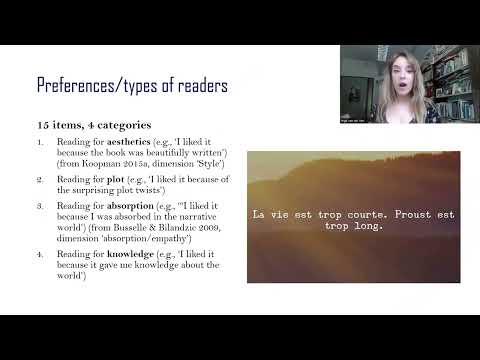 Speaker: Inge van de Ven
Speaker: Inge van de Ven
 Affiliation: Tilburg University
Affiliation: Tilburg University
**Title: Are literary readers close readers? An explorative survey study of reading, attention, and cognitive patience
> Abstract (long version below): Are literary readers better at focused and prolonged concentration? Are they exclusively ‘close readers’, or do they combine different modes of reading? This survey-based study assessed the relations between reading literature, concentration, and perseverance (‘cognitive patience’). We looked at the correlations between hyperreading (e.g., skimming, scanning, and skipping) and cognitive patience, and the influence of preference for longer text length. Our results suggest that reading literature correlates with cognitive patience. Literary readers score high on perseverance and concentration, yet they are not exclusively ‘close readers’: when information is ‘too obvious’, they skim or skip. Insights could help improve reading education.

 Long abstract
Long abstract
In our age of information overload, technological developments are changing how we read. The last decades have witnessed a shift from close reading (careful, attentive reading of the text in a linear manner) to hyperreading (skimming, scanning, and other forms of non-linear reading). Literary reading is typically associated with the former, whereas screen-based reading is commonly associated with the latter. Hyperreading, however, is not only employed on screens: the more people read from screens, the more they get used to quickly scanning texts (Delgado et al., 2018). This means we lose something of value, as acts of reading extended prose fiction such as novels helps develop our ‘cognitive patience’ (Wolf, 2018), i.e., focused attention and ability to delay gratification. In this talk, we report the results from a survey study developed to answer the following questions: Are avid literary readers better at focused and prolonged concentration? Are they exclusively ‘close readers’, or do they combine different modes of reading?
Hypotheses:
H1. Attentive reading of longer literary texts correlates with cognitive patience.
H2. A preference for texts that require sustained attention correlates with cognitive patience.
H3. Preference to skim or skip text passages negatively predicts cognitive patience.
Data were collected in an online survey (N=829; 237 male, 569 female participants; Mage= 43.8, SD=17.1, ranging from 18 to 84).
We measured print exposure by an adapted Author Recognition Test (ART) (Brysbaert et. al., 2020). The range of the ART was from 0 to 31 (M=16.47, SD=8.88). Self-reported frequency of reading was measured on a 5-point Likert scale, as well as duration and preferential text length. We measured frequency of engaging in skimming and scanning with three items. We measured self-reported cognitive patience through 15 items on concentration and perseverance. Last, cognitive patience was tested through an Unscramble Sentence Test (UST).
[Results]
To estimate the validity of our behavioral measure for cognitive patience, we examined whether self-reported persistence would predict scores on the UST. A factor-analysis on the persistence items resulted in four factors: perseverance; hyper-attention; absorption; and missing out on relevant information. Results of a regression analysis revealed that self-reported perseverance (Beta=.104, p=.009) and absorption (Beta=.088, p=.029) are not strong but nevertheless significant predictors of scores on our behavioral measure for cognitive patience, suggesting that our UST may be a reliable behavior measure for persistence (F(2, 790)=11.176, p=.000, Adjusted R2= .025).
H1. Significant positive relations were found between the UST scores and the ART (r=.380, p =.000) and self-reported reading frequency (r=.168, p=.000); persistence (r=.142, p =.000), and absorption (r=.138, p =.000); reported preference for reading longer texts (r=.185, p=.000); negative relations with self-reporting skimming (r= -.116, p=.001) and skipping r= -.105, p=.003). Using a stepwise regression analysis, a significant model emerged (F(3,740)=60.594, p=.000, Adjusted R2=.194, with ART-scores and age predicting higher (Beta=.313, p=.000 and Beta=.205, p=.000 resp.) and self-reported skipping behavior predicting lower scores on UST (Beta=-.071, p=.033). These results confirm H1.
H2. Factor analyses on items related to reading preferences resulted in four factors: entertainment, absorption, aesthetics, and information. Positive correlations were found for aesthetics and information, and a negative correlation for entertainment. Running a stepwise regression analysis, a significant model emerged (F(4, 723= 27.946, p=.000, Adjusted R2= .129, with age (Beta=.309), aesthetics (Beta=.088), p =.015) and informative reading (Beta=.075, p=.039) showing a positive relation with UST, and entertainment as a negative predictors of UST-scores (Beta= -. 099, p=.004). Although relations are weak, these results support our second hypothesis.
H3. We ran Mann-Whitney U-tests comparing UST scores for participants that reported skipping and skimming versus those participants that did not. We found significantly lower scores for those participants who skip and skim certain passages. We saw the reverse for skimming and skipping passages with “too obvious information”, with significantly higher UST scores for participants who skim or skip such passages than those who reported they do not. Finally, participants that indicated they do not skim or skip scored significantly higher on the UST.
Our results suggest that reading literature correlates with cognitive patience. Avid literary readers score high on perseverance and concentration, yet they are not necessarily ‘close readers’ all the time: when ‘too obvious’ information is offered, they skim or even skip text. Insights derived from further empirical study into this topic could help improve the reading education, especially of digital natives, by training them in cognitive patience, but also in the combination of different modes of reading.
References
Brysbaert, M., et al. (2020). Dutch Author Recognition Test. Journal of Cognition, 3(1): 6, pp. 1–14. DOI: https://doi.org/10.5334/joc.95
Delgado, P., Vargas, C., Ackerman, R., & Salmerón, L. (2018). Don’t throw away your printed books: A meta-analysis on the effects of reading media on reading comprehension. Educational Research Review , 25, 23-38.
Wolf, M. (2018). Reader, come home: The reading brain in a digital world. HarperCollins.

